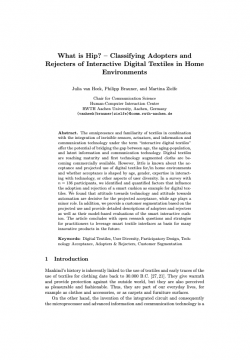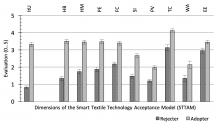
Abstract
The omnipresence and familiarity of textiles in combination with the integration of invisible sensors, actuators, and information and communication technology under the term “interactive digital textiles” offer the potential of bridging the gap between age, the aging-population, and latest information and communication technology. Digital textiles are reaching maturity and first technology augmented cloths are becoming commercially available. However, little is known about the acceptance and projected use of digital textiles for/in home environments and whether acceptance is shaped by age, gender, expertise in interacting with technology, or other aspects of user diversity. In a survey with n=136 participants, we identified and quantified factors that influence the adoption and rejection of a smart cushion as example for digital textiles. We found that attitude towards technology and attitude towards automation are decisive for the projected acceptance, while age plays a minor role. In addition, we provide a customer segmentation based on the projected use and provide detailed descriptions of adopters and rejecters as well as their model-based evaluations of the smart interactive cushion. The article concludes with open research questions and strategies for practitioners to leverage smart textile interfaces as basis for many innovative products in the future.
Heek, J. Van, Brauner, P., Zielfe, M.: What is Hip ? – Classifying Adopters and Rejecters of Interactive Digital Textiles in Home Environments. In: Information and Communication Technologies for Ageing Well and e-Health. ICT4AWE 2017. Communications in Computer and Information Science. pp. 1–20. Springer, Cham (2018).
Related Project(s):
